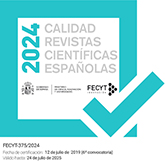The relationship between perception and production of Brazilian Portuguese vowels in European Spanish monolinguals
DOI:
https://doi.org/10.3989/loquens.2016.031Keywords:
non-native perception, non-native production, interrelationAbstract
This study investigates the relationship between non-native perception and production of Brazilian Portuguese (BP) vowels by eight European Spanish monolinguals. Participants’ accuracy on a non-native discrimination task was used to predict performance in non-native production. We also investigated the acoustic similarity between participants’ non-native and native vowel productions. The findings indicate a perception-production link: non-native vowels which were perceptually difficult to discriminate were also less stable and more varied when produced. These findings support the claim of the Second Language Linguistic Perception model (Escudero, 2005; van Leussen & Escudero, 2015) that learners initially perceive and produce the sounds of a second language according to the acoustic properties of the sounds produced in their native language.
Downloads
References
Baker, W., & Trofimovich, P. (2006). Perceptual paths to accurate production of L2 vowels : The role of individual differences. IRAL, International Review of Applied Linguistics in Language Teaching, 44(3), 231–250. https://doi.org/10.1515/IRAL.2006.010
Best, C. T. (1994). The Emergence of Native-Language Phonological Influences in Infants : A Perceptual Assimilation Model. In J. C. Goodman & H. C. Nusbaum (Eds.), The Development of Speech Perception: The Transition from Speech Sounds to Spoken Words (pp. 167–224). Cambridge, MA: MIT Press.
Best, C. T. (1995). A direct realist perspective on cross-language speech perception. In W. Strange (Ed.), Speech perception and linguistic experience: Issues in cross-language research (pp. 171–204). Timonium, MD: York Press. PMid:7604247
Best, C. T., & Tyler, M. D. (2007). Non-native and second-language speech perception: commonalities and complementarities. In O. Bohn & M. J. Munro (Eds.), Language Experience in Second-Language Speech Learning: In Honor of James Emil Flege (pp. 13–34). Amsterdam: John Benjamins. https://doi.org/10.1075/lllt.17.07bes
Bohn, O., & Flege, J. E. (1990). Interlingual identification and the role of foreign language experience in L2 vowel perception, Applied Psycholinguistics, 11, 303–328. https://doi.org/10.1017/S0142716400008912
Bongaerts, T., Van Summeren, C., Planken, B., & Schils, E. (1997). Age and ultimate attainment in the pronunciation of a foreign language. Studies in Second Language Acquisition, 19(4), 447–465. https://doi.org/10.1017/S0272263197004026
Colantoni, L., Steele, J., & Escudero, P. (2015). Second Language Speech. Cambridge: Cambridge University Press.
Elliott, A. R. (1995). Foreign Language Phonology : Field Independence, Attitude, and the Success of Formal Instruction in Spanish Pronunciation. The Modern Language Journal, 79, 356–371. https://doi.org/10.1111/j.1540-4781.1995.tb01112.x
Elvin, J. (2016). The role of the native language in non-native perception and spoken word recognition: English vs. Spanish learners of Portuguese. PhD Dissertation, Western Sydney University.
Elvin, J., & Escudero, P. (2015). Predicting discrimination accuracy through cross-linguistic acoustic analyses. In The Scottish Consortium for ICPhS 2015 (Ed.), Proceedings of the 18th International Congress of Phonetic Sciences. Glasgow, UK: The University of Glasgow.
Escudero, P. (2005). Linguistic Perception and Second Language Acquisition. PhD Dissertation, Utrecht University.
Escudero, P. (2009). The linguistic perception of similar L2 sounds. In P. Boersma & S. Hamann (Eds.) Phonology in Perception (pp. 152–190). Berlin-New York: Mouton de Gruyter.
Escudero, P., & Boersma, P. (2004). Bridging the gap between L2 speech perception research and phonological theory. Studies in Second Language Acquisition, 26(4), 551–585. https://doi.org/10.1017/S0272263104040021
Escudero, P., Boersma, P., Rauber, A. S., & Bion, R. H. (2009). A cross-dialect acoustic description of vowels: Brazilian and European Portuguese. The Journal of the Acoustical Society of America, 126(3), 1379–1393. https://doi.org/10.1121/1.3180321 PMid:19739752
Escudero, P., & Vasiliev, P. (2011). Cross-language acoustic similarity predicts perceptual assimilation of Canadian English and Canadian French vowels. The Journal of the Acoustical Society of America, 130(5), EL277–EL283. https://doi.org/10.1121/1.3632043 PMid:22088028
Flege, J. E. (1987). The production of "new" and "similar" phones in a foreign language: evidence for the effect of equivalence classification. Journal of Phonetics, 15(1), 47–65.
Flege, J. E. (1988). Factors affecting degree of perceived foreign accent in English sentences. The Journal of the Acoustical Society of America, 84(1), 70. https://doi.org/10.1121/1.396876 PMid:3411056
Flege, J. E. (1991). Age of learning affects the authenticity of voiceonset time (VOT) in stop consonants produced in a second language. The Journal of the Acoustical Society of America, 89(1), 395–411. https://doi.org/10.1121/1.400473 PMid:2002177
Flege, J. E. (1995). Second language speech learning: Theory, findings, and problems. In W. Strange (Ed.), Speech perception and linguistic experience: Issues in cross-language research (pp. 233–276). Timonium, MD: York Press.
Flege, J. E., Bohn, O.-S., & Jang, S. (1997). Effects of experience on non-native speakers' production and perception of English vowels. Journal of Phonetics, 25(4), 437–470. https://doi.org/10.1006/jpho.1997.0052
Flege, J. E., Frieda, E. M., & Nozawa, T. (1997). Amount of nativelanguage (L1) use affects the pronunciation of an L2. Journal of Phonetics, 25(2), 169–186. https://doi.org/10.1006/jpho.1996.0040
Flege, J. E., Mackay, I. R. A., & Meador, D. (1999). Native Italian speakers ' perception and production of English vowels, The Journal of the Acoustical Society of America, 106(5), 2973–2987. https://doi.org/10.1121/1.428116 PMid:10573909
Flege, J. E., Munro, M. J., & Mackay, I. R. A. (1995). Factors affecting strength of perceived foreign accent in a second language. The Journal of the Acoustical Society of America, 97, 3125. https://doi.org/10.1121/1.413041
Gilichinskaya, Y. D., & Strange, W. (2010). Perceptual assimilation of American English vowels by inexperienced Russian listeners. The Journal of the Acoustical Society of America, 128(2), EL80–EL85. https://doi.org/10.1121/1.3462988 PMid:20707419
Johnson, J. S., & Newport, E. L. (1991). Critical period effects on universal properties of language: the status of subjacency in the acquisition of a second language. Cognition, 39(3), 215–258. https://doi.org/10.1016/0010-0277(91)90054-8
Kisler, T., Schiel, F., & Sloetjes, H. (2012). Signal processing via webservices: the use case WebMAUS. In Proceedings of Digital Humanities (pp. 30–34). Hamburg.
Levy, E. S. (2009). On the assimilation-discrimination relationship in American adults' French vowel learning. The Journal of the Acoustical Society of America, 126(5), 2670–2682. https://doi.org/10.1121/1.3224715 PMid:19894844 PMCid:PMC2787078
Levy, E. S., & Law, F. F. (2010). Production of French vowels by American-English learners of French: language experience, consonantal context, and the perception-production relationship. The Journal of the Acoustical Society of America, 128(3), 1290–1305. https://doi.org/10.1121/1.3466879
Llisterri, J. (1995). Relationships between speech production and speech perception in a second language. In Proceedings of the XIIIth International Congress of Phonetic Sciences (Vol. 4, pp. 92–99).
Marslen-Wilson, W. D. (1985). Speech shadowing and speech comprehension. Speech Communication, 4(1–3), 55–73. https://doi.org/10.1016/0167-6393(85)90036-6
Morrison, G. S. (2003). Perception and Production of Spanish Vowels by English Speakers. In Proceedings of the 15th International Congress of Phonetic Sciences (Vol. 2003, pp. 1533–1536). Barcelona.
Morrison, G. S. (2004). An acoustic and statistical analysis of Spanish mid-vowel allophones. Estudios de Fonética Experimental, 13, 12–37.
Morrison, G. S. (2006). L1 & L2 Production and Perception of English and Spanish Vowels: A Statistical Modelling Approach. PhD Dissertation, University of Alberta.
Moyer, A. (1999). Ultimate attainment in L2 phonology. Studies in Second Language Acquisition, 21(1), 81–108. https://doi.org/10.1017/S0272263199001035
Navarro Tomás, T. (1918). Manual de pronunciación espa-ola [1965 (12th ed.)]. Madrid: CSIC.
Piske, T., MacKay, I. R. A., & Flege, J. E. (2001). Factors affecting degree of foreign accent in an L2 : a review. Journal of Phonetics, 29(2), 191–215. https://doi.org/10.1006/jpho.2001.0134
Rallo Fabra, L., & Romero, J. (2012). Native Catalan learners' perception and production of English vowels. Journal of Phonetics, 40(3), 491–508. https://doi.org/10.1016/j.wocn.2012.01.001
Rauber, A. S., Escudero, P., Bion, R. A. H., & Baptista, B. O. (2005). The Interrelation between the Perception and Production of English Vowels by Native Speakers of Brazilian Portuguese Graduate Program in Applied Linguistics. INTERSPEECH, 2, 2913–2916.
Scovel, T. (1969). Foreign accents, language acquisition, and cerebral dominance. Language Learning, 19(3–4), 245–253. https://doi.org/10.1111/j.1467-1770.1969.tb00466.x
Scovel, T. (2000). A critical review of the critical period research. Annual Review of Applied Linguistics, 20, 213–223. https://doi.org/10.1017/S0267190500200135
Sheldon, A. M. Y., & Strange, W. (1982). The acquisition of /r/ and /l/ by Japanese learners of English : Evidence that speech production can precede speech perception. Applied Psycholinguistics, 3(3), 243–261. https://doi.org/10.1017/S0142716400001417
Smit, U. (2002). The interaction of motivation and achievement in advanced EFL pronunciation learners. IRAL, 40(2), 89–116. https://doi.org/10.1515/iral.2002.009
van Leussen, J.-W., & Escudero, P. (2015). Learning to perceive and recognize a second language: the L2LP model revised. Frontiers in Psychology, 6(August), 1–12. https://doi.org/10.3389/fpsyg.2015.01000
Wanrooij, K., Escudero, P., & Raijmakers, M. E. J. (2013). What do listeners learn from exposure to a vowel distribution ? An analysis of listening strategies in distributional learning. Journal of Phonetics, 41(5), 307–319. https://doi.org/10.1016/j.wocn.2013.03.005
Published
How to Cite
Issue
Section
License
Copyright (c) 2016 Consejo Superior de Investigaciones Científicas (CSIC)

This work is licensed under a Creative Commons Attribution 4.0 International License.
© CSIC. Manuscripts published in both the print and online versions of this journal are the property of the Consejo Superior de Investigaciones Científicas, and quoting this source is a requirement for any partial or full reproduction.
All contents of this electronic edition, except where otherwise noted, are distributed under a Creative Commons Attribution 4.0 International (CC BY 4.0) licence. You may read here the basic information and the legal text of the licence. The indication of the CC BY 4.0 licence must be expressly stated in this way when necessary.
Self-archiving in repositories, personal webpages or similar, of any version other than the final version of the work produced by the publisher, is not allowed.














